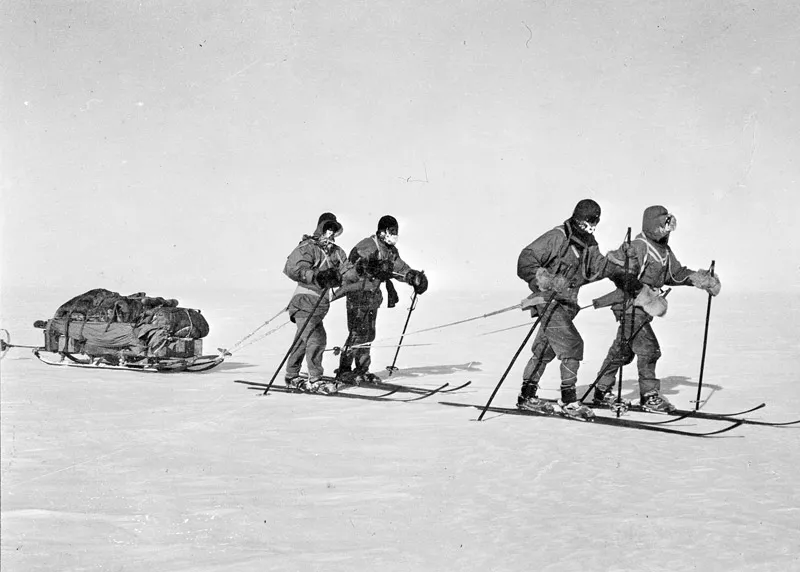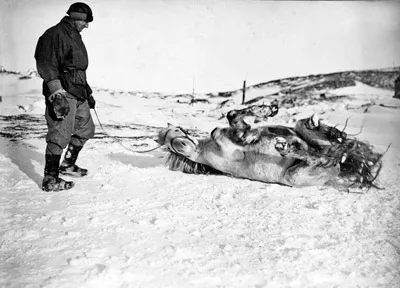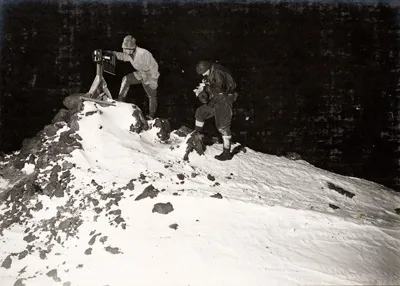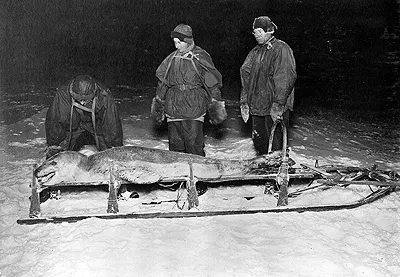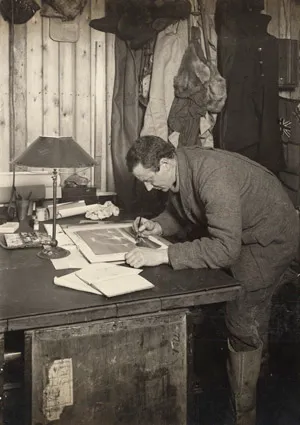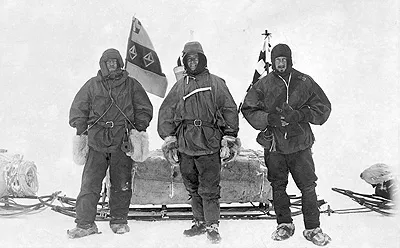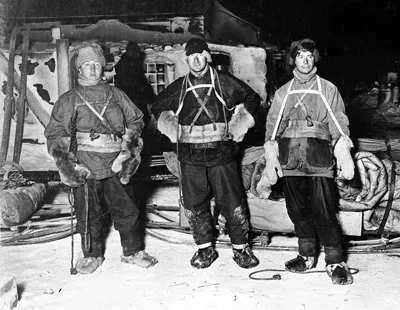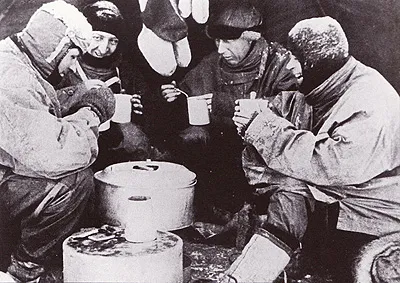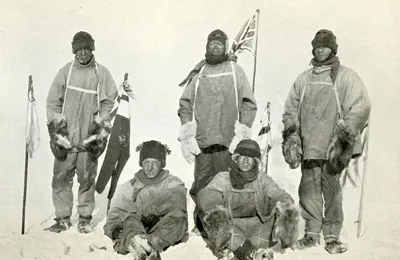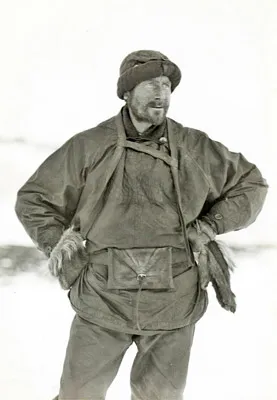Edward Adrian Wilson
Chief of scientific staff, biologist
1872 - 1912
Biographical notes
Assistant surgeon
Discovery
1901-04
Chief of scientific staff, biologist
Terra Nova
1910-13
Edward
Wilson's watercolour paintings of Antarctica
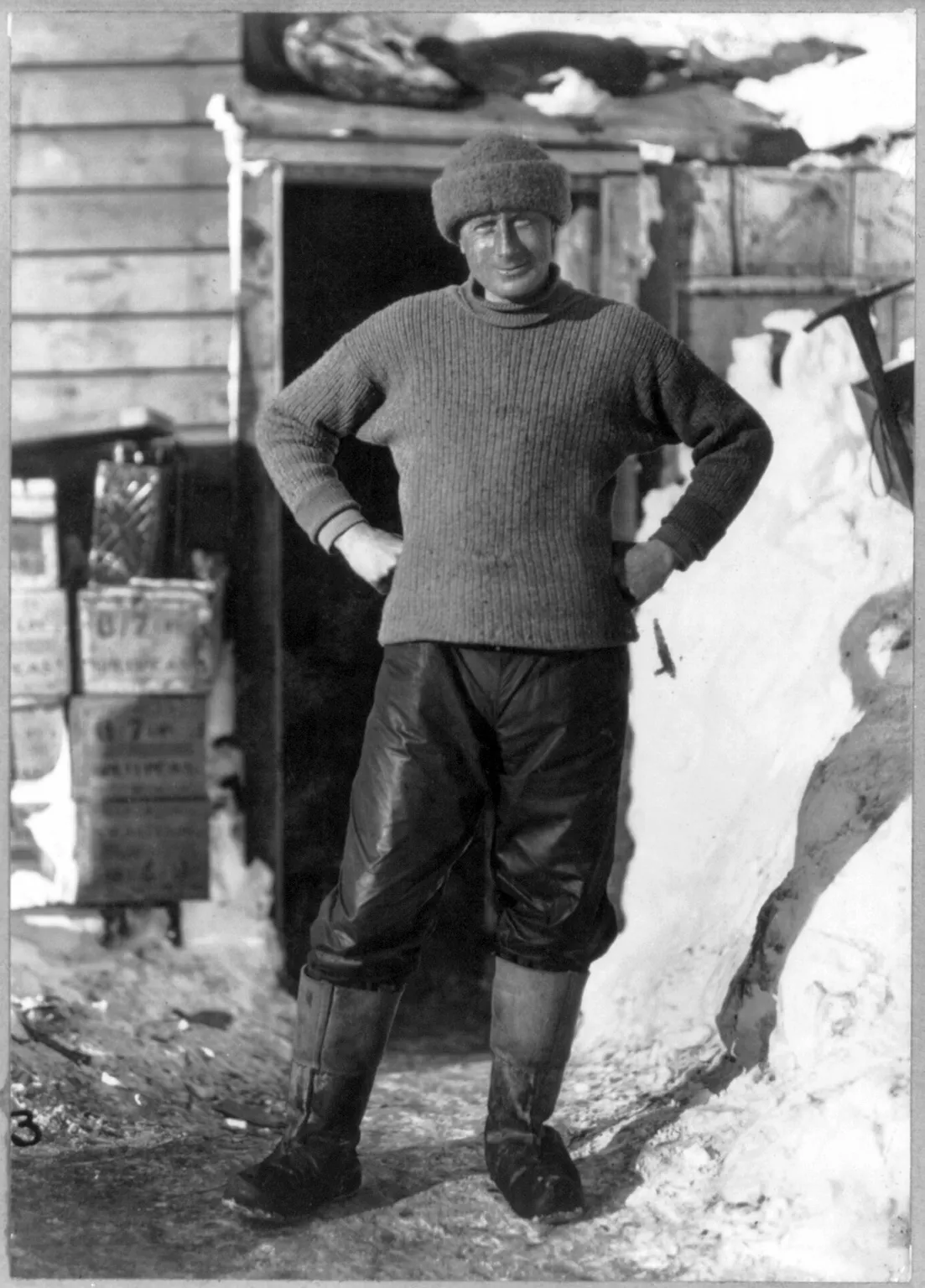
Edward Wilson - Uncle
Bill
23rd July
1872 - 29th March 1912
One of the most prominent figures of early Antarctic exploration because of his easy manner and the great respect he received from the men he worked with, because of the paintings and drawings he made and because he was one of the five men making up Scott's team that reached the South Pole, but died on the return journey.
Born in Cheltenham, England, the son of a physician, educated at Cheltenham College and Caius College Cambridge where he read Zoology before qualifying in medicine at St. George's Hospital London. Shortly after he qualified as a doctor, Wilson became ill with tuberculosis, during the long convalescence he practiced and developed his skills as an artist.
In 1901, Wilson applied to be doctor on Scott's Discovery Expedition to Antarctica, he was the second doctor to be appointed, originally because there was to be a landing party separate from the main expedition - this never happened however and both doctors stayed with the expedition. He was not fully recovered from his illness when first appointed, but Scott saw his potential and took him on as vertebrate zoologist and artist as well as doctor.
Expeditions, then and now take doctors, but it is expected that with the high level of fitness of the men, the doctor should have relatively little to do in the way of medicine, with the exception of accidents or unforeseen illness, so there is always a secondary occupation that the doctor can fulfill until such time that the medical skills are needed. Wilson's specific job was to deal with the birds and seals that the Expedition came across and to write the appropriate section for publication in the report of the expedition.
He made an attempt on the South Pole with Scott and Shackleton in 1902, they reached the furthest south point at that time, 480 miles from the pole, Shackleton was suffering from scurvy and unable to pull the sledge, after 93 days and 960 miles, they managed to struggle back to safety. Shackleton invited him to join his Nimrod expedition in 1907, but he declined, partly from loyalty to Scott.
On the Terra Nova Expedition Wilson accompanied Cherry-Garrard and Bowers on a trip to Cape Crozier to retrieve an emperor penguin egg during the winter of 1911, famously written about in Cherry-Garrard's book "The Worst Journey in the World". The three men endured the coldest temperatures recorded on the expedition, as low as -57C (-70F) in the dark of the Antarctic night.
Wilson was involved with depot laying in January-March 1911 as preparation for the south pole attempt later in the year. Starting in November 1911 he accompanied Scott's Polar Party initially by leading a pony named Nobby pulling a sledge of supplies and later manhauling as the ponies were killed as they got nearer the pole, food ran out for them and conditions became more difficult. He was one of the 5 men who made up the final South Pole Party, while they made it successfully to the South Pole on the 17th of January 1912, they all perished on the return journey. Wilson died in the tent at the last camp with Scott and Bowers at the age of 39.
-
"Wilson and Bowers were found in the attitude of sleep, their sleeping-bags
closed over their heads as they would naturally close them."
A lasting and acclaimed legacy is the collection of water colour pictures that he made during his two Antarctic expeditions, E. A. Wilson's watercolours. There is a statue of him in Cheltenham sculptured by Scott's widow Kathleen.
"Words must always fail me when I talk of Bill Wilson. I believe he really is the finest character I ever met." - Scott
Captain Scott and Dr. Wilson with the Pony 'Nobby' (1912), video 24 secs
References to Edward Wilson by Cherry-Garrard in "The Worst Journey in the World"
-
However much of good I may write of Wilson, his many friends in England, those who served with him on the ship or in the hut, and most of all those who had the good fortune to sledge with him (for it is sledging which is far the greatest test) will all be dissatisfied, for I know that I cannot do justice to his value. If you knew him you could not like him: you simply had to love him. Bill was of the salt of the earth. If I were asked what quality it was before others that made him so useful, and so lovable, I think I should answer that it was because he never for one moment thought of himself
-
The first days out from England were spent in such hard and crowded work that we shook down very quickly. I then noticed for the first time Wilson's great gift of tact, and how quick he was to see the small things which make so much difference.
-
Certain men already began to stand out. Wilson, with an apparently inexhaustible stock of knowledge on little things and big; always ready to give help, and always ready with sympathy and insight, a tremendous worker, and as unselfish as possible; a universal adviser.
-
Wilson was a man of many parts. He was Scott's right-hand man, he was the expedition's Chief of the Scientific Staff: he was a doctor of St. George's Hospital, and a zoologist specializing in vertebrates. His published work on whales, penguins and seals contained in the Scientific Report of the Discovery Expedition is still the best available, and makes excellent reading even to the non-scientist. On the outward journey of the Terra Nova he was still writing up his work for the Royal Commission on Grouse Disease, the published report of which he never lived to see. But those who knew him best will probably remember Wilson by his water-colour paintings rather than by any other form of his many-sided work.
-
Wilson was not a particularly strong man. On leaving with the Discovery he was but lately cured of consumption, yet he went with Scott to his farthest South, and helped to get Shackleton back alive. Shackleton owed his life to those two. Wilson was of a slimmer, more athletic build, a great walker, 5 feet 10 1/2 inches in height, 11 stones in weight, with a chest measurement of 36 inches. He was an ideal example of my contention, which I believe can be proved many times over to be a fact, that it is not strength of body but rather strength of will which carries a man farthest where mind and body are taxed at the same time to their utmost limit.
References to Edward Wilson by Scott in "Scott's Last Expedition"
-
One sees Wilson busy with pencil and colour box, rapidly and steadily adding to his portfolio of charming sketches and at intervals filling the gaps in his zoological work of Discovery times; withal ready and willing to give advice and assistance to others at all times; his sound judgment appreciated and therefore a constant referee.
-
After a short experience they found that Wilson, who had arranged for the greatest quantity of fat, had too much of it, and C.-G., who had gone for biscuit, had more than he could eat. A middle course was struck which gave a general proportion agreeable to all, and at the same time suited the total quantities of the various articles carried.
-
Words must always fail me when I talk of Bill Wilson. I believe he really is the finest character I ever met - the closer one gets to him the more there is to admire. Every quality is so solid and dependable; cannot you imagine how that counts down here? Whatever the matter, one knows Bill will be sound, shrewdly practical, intensely loyal and quite unselfish. Add to this a wider knowledge of persons and things than is at first guessable, a quiet vein of humour and really consummate tact, and you have some idea of his values. I think he is the most popular member of the party, and that is saying much.
-
I think Wilson, Bowers and I are as fit as possible under the circumstances.
-
Wilson has strained a tendon in his leg; it has given pain all day and is swollen to-night. Of course, he is full of pluck over it, but I don't like the idea of such an accident here.
-
Marching in the afternoon, I kept more to the left, and closed the mountain till we fell on the stone moraines. Here Wilson detached himself and made a collection, whilst we pulled the sledge on.
-
I don't know what I should do if Wilson and Bowers weren't so determinedly cheerful over things.
-
We none of us expected these terribly low temperatures, and of the rest of us Wilson is feeling them most; mainly, I fear, from his self-sacrificing devotion in doctoring Oates' feet. We cannot help each other, each has enough to do to take care of himself.
-
I practically ordered Wilson to hand over the means of ending our troubles to us, so that anyone of us may know how to do so. Wilson had no choice between doing so and our ransacking the medicine case. We have 30 opium tabloids apiece and he is left with a tube of morphine.
-
Blizzard bad as ever - Wilson and Bowers unable to start - to-morrow last chance - no fuel and only one or two of food left - must be near the end.
-
To Mrs. E. A. Wilson
My Dear Mrs. Wilson. If this letter reaches you, Bill and I will have gone out together. We are very near it now and I should like you to know how splendid he was at the end - everlastingly cheerful and ready to sacrifice himself for others, never a word of blame to me for leading him into this mess. He is not suffering, luckily, at least only minor discomforts.
His eyes have a comfortable blue look of hope and his mind is peaceful with the satisfaction of his faith in regarding himself as part of the great scheme of the Almighty. I can do no more to comfort you than to tell you that he died as he lived, a brave, true man - the best of comrades and staunchest of friends.
My whole heart goes out to you in pity. Yours,
R. Scott.
Landmarks named after Edward Wilson
Feature Name:
Wilson Hills
Type: range
Latitude:
69°40'S
Longitude: 158°30'E
Description: A group of scattered hills,
nunataks and ridges that extend NW-SE for about 70 mi between
Matusevich Glacier and Pryor Glacier. Discovered by Lt. H.L.L.
Pennell, RN, on the Terra Nova in Feb. 1911 during Scott's
last expedition.
Feature Name:
Wilson Piedmont Glacier
Type: glacier
Latitude: 77°15'S
Longitude:
163°10'E
Description:
A large piedmont glacier extending from Granite Harbor to Marble
Point on the coast of Victoria Land. Discovered by the British
National Antarctic Expedition, 1901-04, but not named until
the British National Antarctic Expedition, 1910-13.
Feature Name: Cape Wilson
Type: cape
Latitude:
82°14'S
Longitude: 163°47'E
Description: A bold, rocky, snow-covered
cape, forming the SE end of the Nash Range and marking the northern
entrance point to Shackleton Inlet on the western edge of the
Ross Ice Shelf. Discovered by Capt. Robert F. Scott, RN, in
December 1902, on his attempted trip to the South Pole. He was
accompanied on this trip by Lt. (later Sir) Ernest H. Shackleton,
RNR, and Dr. Edward A. Wilson.
Other Crew of the Terra Nova Expedition
Abbot,
George Percy - Petty Officer, R.N. - 1, 2, N
Atkinson, Edward
L. - R.N. - surgeon, parasitologist - 1, 2, D, P, S
Balson,
Albert - Leading seaman, R.N.- 1, 2
Bowers,
Henry Robertson - Lieutenant - 1, 2, D, C,
Po
Browning,
Frank Vernon - Petty Officer - 1, 2, N
Campbell,
Victor - Lieutenant, R.N. - 1, 2, N
Cheetham,
Alfred B. - Boatswain (Bosun), R.N.R.
Cherry-Garrard,
Apsley - Assistant zoologist - 1, 2, D, C, S
Crean,
Tom - petty officer, R.N. - 1, 2, D, P, S
Debenham, Frank
- Geologist - 1, 2, iW, iiW
Dickason,
Harry - Able Seaman - 1, 2, N
Evans, Edgar - petty
officer, R.N. - 1, iW, Po
Evans, Edward R.G.R. - Lieutenant, R.N. "Teddy Evans" -
second in command, and Captain of the Terra Nova - 1, D, P
Girev
(Geroff), Dmitriy - Dog driver - 1, 2, D, P, S
Gran,
Tryggve - ski expert - 1, 2, D, iiW, S
Lashly, William
- chief stoker, R.N. - 1, 2, P, S
Levick,
G. Murray - Surgeon, R.N. - 1, 2, N
Lillie, Dennis Gascoigne - Biologist
on the ship
McLeod, Thomas
F. - Able seaman - 1, 2
Meares, Cecil
H. - in charge of dogs - 1, D, P
Oates, Lawrence
- Capt. 6th Iniskilling Dragoons - 1, D,
Po
Ponting,
Herbert G. - Camera artist - 1
Priestley,
Raymond E. - Geologist - 1, 2, N
Omelchenko,
Anton - Groom - 1
Scott, Robert
Falcon - Commander, R.N. -
Expedition leader - 1, D, Po
Simpson,
George - Meteorologist - 1
Taylor,
T. Griffith - Geologist - 1, iW, iiW
Wilson,
Edward Adrian - chief of scientific staff and biologist - 1, D, C,
Po
Wright,
Charles Seymour - Physicist - 1, 2, iW, P, S
Key:
1 - first winter
2 - second winter
iW - first western party
iiW - second western party
N - northern
party
D - depot laying for south pole journey
P - south pole party
C - winter journey to Cape Crozier
S - search party for south Pole
party
Po - reached
South Pole
Biographical information
- I am concentrating on the Polar experiences of the men involved.
Any further information or pictures visitors may have will be gratefully received.
Please email
- Paul Ward, webmaster.
What are the chances that my ancestor was an unsung part of the Heroic Age
of Antarctic Exploration?

